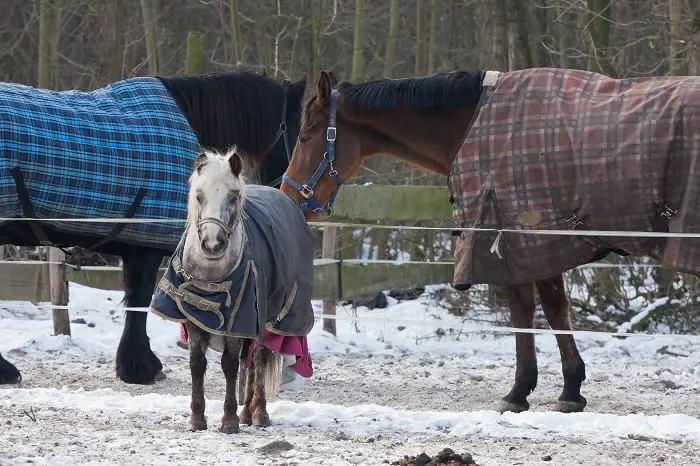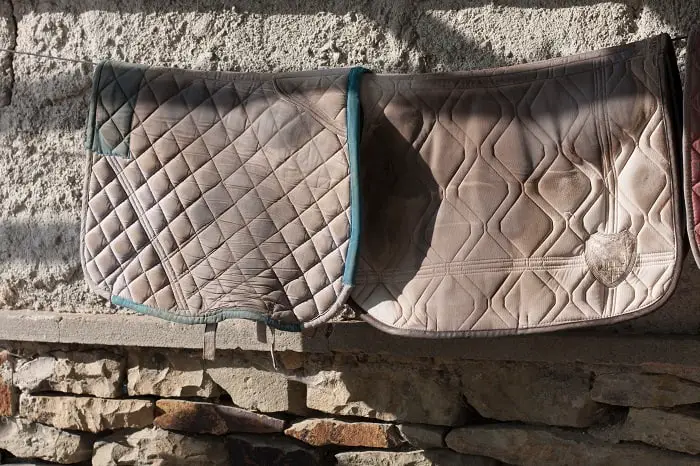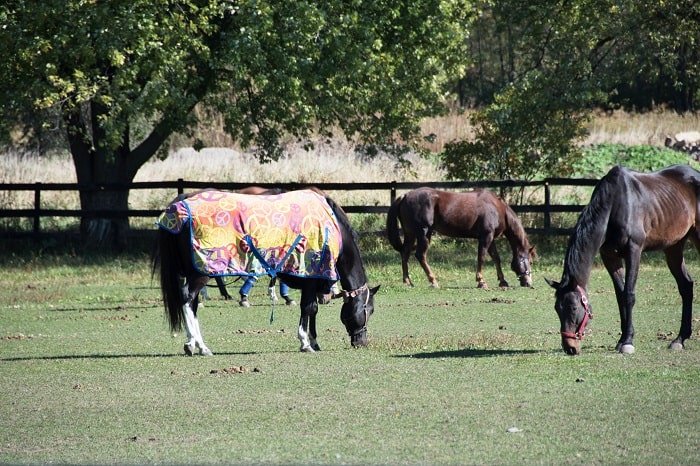Last Updated on December 8, 2022
Horse blanketing is a personal topic for many riders. When to blanket a horse, if you’re blanketing at all, depends a great deal on your personal horse and its needs.
Thus, we have prepared this helpful overview on horse blanketing, including a ‘when to blanket a horse temperature’ chart, to help you understand the when, hows, and whys of blanketing your horse.
When to Blanket A Horse: Proper Blanketing Tips
Simply put, you should blanket a horse when they are cold and seem uncomfortable. If your horse is shivering, this is a clear indication that their core body temperature is dropping and they need immediate assistance to stay warm.

You must address shivering immediately because if a horse lets its core temperature drop for too long, it will make them vulnerable to illnesses.
When to Blanket A Horse: Factors That Can Lower Your Horse’s Internal Temperature
Weather Changes
As the weather gets colder, it becomes more difficult for your horse to regulate themselves to a normal temperature. As such, you should start to blanket your horse as the weather starts to drop below 50°.
And to ease your horse into having a blanket on, Equus Magazine suggests you use a quarter sheet under your saddle when riding your horse, to allow his back muscles to gradually adjust to the blanket as he moves.
Horses Coat
When a horse’s coat is allowed to grow out in the winter months, it naturally creates a layer of hair that helps keep its temperature regulated. For horses showing in the winter, having this growth is not always an option and they need to have their body clipped.
And if your horse’s hair is clipped, you may need to start blanketing them earlier and also use heavier weighted blankets than a horse without a clipped coat.
Aging Horse/Illness
Horses that are not in their prime will typically need to be blanketed at the first sign of cold weather. Due to their lower muscle mass and fat, their lack of insulation makes them more likely to get ill when it is cold.
As such, you must keep an eye on horses that have a hard time eating large quantities of food, for medical reasons or otherwise, as they will not put on winter weight, and will need to be blanketed earlier.
Find out if Horses Get Cold In The Winter
When to Blanket A Horse: How to Blanket a Horse in Winter
As we just discussed, getting your horse to a normal temperature depends on many things. In this ‘when to blanket a horse temperature guide’ from Stateline Tack, you will see that whether or not your horse is clipped, plays a major role in determining which blanket to use.
Horse Blanketing Guide
Thus, when following this guide, you should remember the other factors which may affect your horse’s normal temperature and watch them carefully to see if an increase or decrease in blanket weight is needed.
| Temperature | Horse with a natural coat | A horse that is body clipped |
| 50° – 60° | Sheet – No Fill | Light Blanket (100 g)
|
| 40° – 50° | Light Blanket (100g) | Light/Medium Blanket (150g – 250g) |
| 30° – 40° | Light/Medium Blanket (150g – 250g) | Medium/Heavy Blanket (200g – 300g) |
| 20° – 30° | Medium/Heavy Blanket (200g – 300g) | Heavy (300g – 400 g) or Medium Blanket |
| Below 20° | Heavy (300g – 400g) | Heavy (300g – 400g) with Blanket Liner |
Blanket A Horse: Different Types of Horse Blankets
There are quite a few different types of horse blankets, but don’t worry, as there are clear guides on what type of blanket to use and when. As the Practical Horseman suggests, these two questions come into play when narrowing down your choices:
- Is your horse turned out in inclement weather?
- Is your horse clipped during the winter or left to grow a coat?
Once you know the answers to these questions, you can then take a look at the options below, and see which kind of blanket is the right fit for you.

Turn Out Blankets For Horses
The defining features of a turnout are that, not only are they waterproof, meaning can be worn outdoors, but they also come in different weights. Currently, there are two types of turnouts to use when you blanket a horse, and they are;
A turnout sheet has no filling. A turnout blanket has a filling in different weights, that will help warm your horse to a normal temperature.
Even though they can be used as a stable blanket, the waterproofing feature serves as an additional cost, even if you don’t plan on using it.
Stable Blankets
Stable blankets also help to keep your horse at a normal temperature, but unlike turnouts, they are not waterproof and should only be used indoors. They come in a variety of weights and horse owners are expected to choose which weight to use, based on the temperature chart above. Stable blankets also come in many styles and patterns so you can personalize the look of what your horse is wearing!
Rain and Fly Sheets
While not technically considered blankets, you might get to see rain and fly sheets as options when looking for horse covers. Rain sheets help keep your horse dry in light rain, fog, and sleet, whereas fly sheets cover your horse’s neck, and tail and protect against bug bites in the humid seasons. Neither of these options is designed to keep your horse warm, so if you are looking out to regulate the temperature in the winter months, you should get your horse either the turnouts or stable blankets.
When Should the Blanket Come Off?
Just as you start to blanket your horse when they are cold, you should stop blanketing them when they are warm. As the temperature rises, you can start blanketing your horse with more lightweight blankets and once it is above 50°, you can stop blanketing altogether.

An important note to remember is that, if a blanket gets wet at any time, remove it as quickly as possible to prevent your horse from getting chilled or rain rot.
Keep Your Horse Happy!
You know your horse best and can see when they are comfortable and happy. As such, keep your horse warm and healthy by following the above blanketing temperature guide and tips, to know when or not to blanket your horse.
How tight should a horse blanket be?
A blanket that is too loose will not provide enough support to keep your horse warm, and it may interfere with the horse’s movement. A blanket that is too tight will be constricting, and it will restrict the horse’s movement. It is very important that a blanket fits well on the withers and shoulders. In that way your horse can move freely without the blanket slipping off his back. Once you adjust the buckles and straps, you need to make sure you can still slide your hand down the neck of the blanket. This simple check ensures that the blanket is not too tight and your horse is feeling comfortable in it.
What does the denier mean on horse blankets?
Denier characterize the strength of a material used for a horse blanket. A material with a higher denier number is stronger than one with a lower denier number. For example, a 1000 denier material would be stronger, more durable, and with better water repellent properties than a 500 denier material. The denier number is also known as the yarn fineness or the yarn count. The denier of a horse blanket is an indication of the thickness of the yarns.
How do you warm up a cold horse?
The fastest way to warm up a cold horse is by getting him to do some exercise. Movement will stimulate the blood flow and at least temporary help with fighting the cold. But this is only a temporary solution. A thick blanket over your horse’s body is the most efficient way to keep him warm for longer periods of time. Your horse will will also need larger volume of hay and feed in the winter to keep his energy levels and body temperature up. It also helps if your horse has the access to a dry shed or shelter where he can hide from the elements.
How do horses do in cold weather?
Depending on the breed of horse and the thickness of their coat, most horses are comfortable at temperatures between 18° and 59° F (-7° to 15° C). However, they are pretty good at adapting to cold temperatures. They grow a thick winter coat that keeps them warm and protects them from the wind and snow. They also maintain their body temperature with a layer of fat under their skin that acts as an insulation for their body in cold winter temperatures. Horses normally put on some extra weight in the fall which helps them keep warm during winter months.
When should I blanket my horse with a winter coat?
The actual answer to this question is somewhat dependent on your local climate and the breed of a horse. Horse breeds originating in temperate climates (North America, Europe, Australia) have a thicker winter coat than horses in tropical climates (Southern and South America, Africa, Asia, and most of the Middle East).
If your horse is a cold-blooded horse, like the draft horse, or Shetland pony, and they don’t have the access to a shelter, you should blanket them once the temperature drops below 5 degrees Farenheit (-15 degrees Celsius) in order to protect them from the cold and provide the extra insulation they need.
If your horse is a warm-blooded horse, like the Quarter Horse, Arabian, or Thoroughbred, you should blanket them once the temperature drops below 15 degrees Farenheit (-10 degrees Celsius). If they are in extreme cold, such as below -20 degrees Farenheit, you should provide them with a shelter form inclement weather.
Michael Dehaan is a passionate horse owner, horse rider, and lover of all things equine. He has been around horses since he was a child, and has grown to become an expert in the field. He has owned and ridden a variety of horses of different breeds, and has trained many to compete in shows and competitions. He is an experienced horseman, having worked with and competed many horses, including his own. He is an active member of the equestrian community, participating in events and teaching riding lessons.
